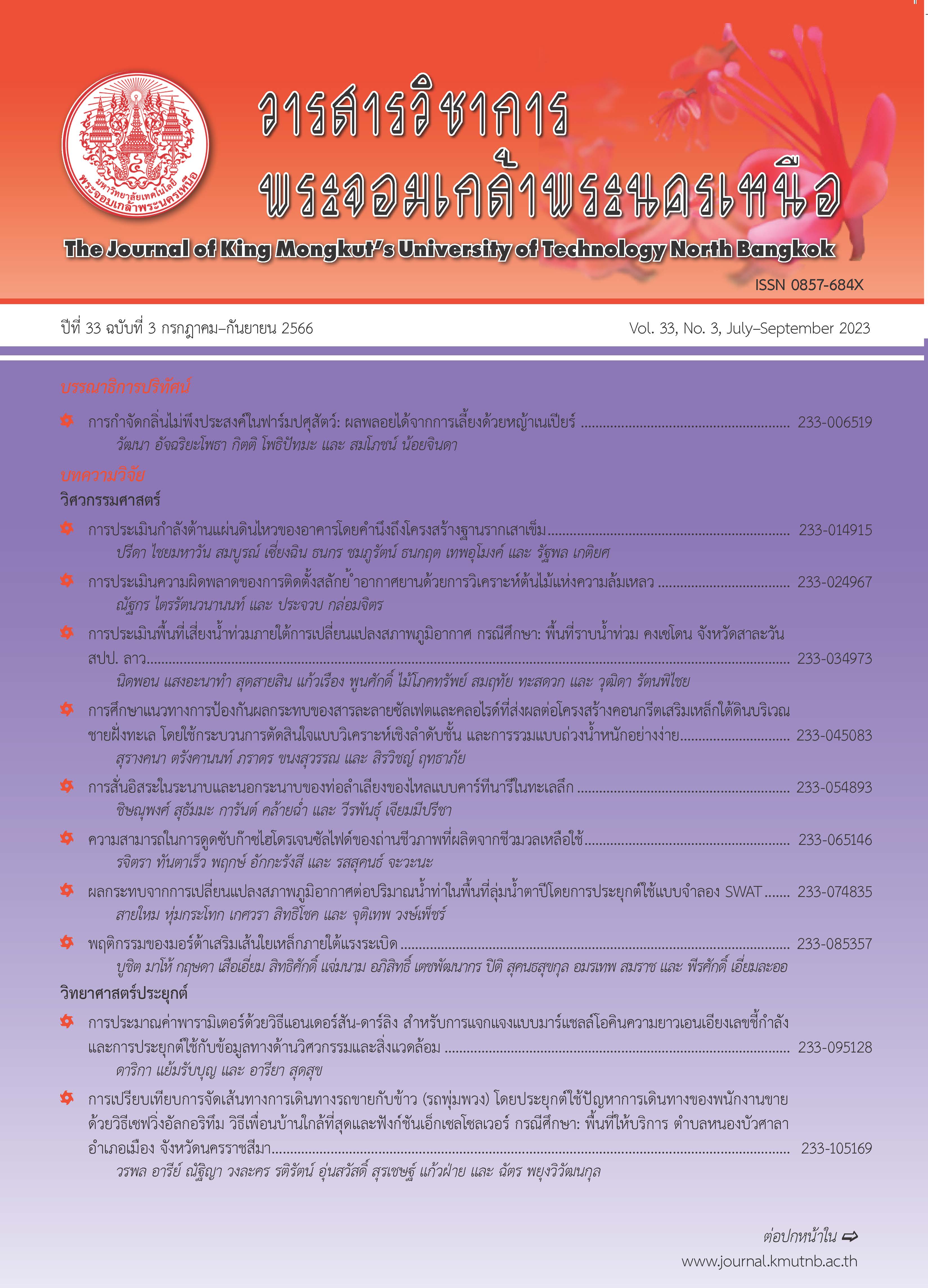อิทธิพลของแคลเซียมคาร์บอเนตต่อสมบัติเชิงกลและต้นทุนการผลิตของวัสดุพอลิแลคติกแอซิดไบโอคอมพอสิต
Main Article Content
บทคัดย่อ
งานวิจัยนี้มีวัตถุประสงค์เพื่อพัฒนาวัสดุไบโอคอมพอสิตฐานพอลิแลคติกแอซิดและปรับปรุงสมบัติเชิงกล ต้นทุนการผลิตและความสามารถในการแข่งขัน โดยใช้เส้นใยเยื่อไม้ยูคาลิปตัสและแคลเซียมคาร์บอเนตเป็นสารเสริมแรง จากการศึกษา พบว่า มอดุลัสต่อการดัดงอของวัสดุไบโอคอมพอสิตมีแนวโน้มเพิ่มขึ้นตามการเพิ่มขึ้นของแคลเซียมคาร์บอเนตและมีค่าสูงสุดที่ 5462 เมกะปาสคาล ในขณะเดียวกันความแข็งแรงต่อการดัดงอและความต้านทานต่อการกระแทกมีค่าลดลงต่ำสุดที่ 22.76 เมกะปาสคาล และ 0.67 กิโลจูลต่อตารางเมตรที่ 35 เปอร์เซ็นต์แคลเซียมคาร์บอเนต ตามลำดับ อย่างไรก็ตามที่ 20 เปอร์เซ็นต์แคลเซียมคาร์บอเนตมีสมบัติเชิงกลที่ดีที่สุด การศึกษาอัตราการแพร่ของน้ำพบว่า วัสดุไบโอคอมพอสิตสามารถต้านทานการแพร่ผ่านของน้ำและค่าความต้านทานต่อการแพร่ผ่านจะลดลงเมื่อปริมาณแคลเซียมคาร์บอเนตเพิ่มขึ้น ในด้านต้นทุนการผลิตของวัสดุไบโอคอมพอสิตได้ทำการคำนวณราคาวัตถุดิบทั้งหมดรวมทั้งค่าผลิตงานพบว่า ต้นทุนอยู่ระหว่าง 108.68–130.28 บาทต่อกิโลกรัม ในขณะที่ต้นทุนของพอลิแลคติกแอซิดอยู่ที่ 155.44 บาทต่อกิโลกรัม เมื่อพิจารณาความสามารถในการแข่งขัน (ความแข็งแรงต่อการดัดงอ/ต้นทุนการผลิต) วัสดุไบโอคอมพอสิตที่ 20 เปอร์เซ็นต์แคลเซียมคาร์บอเนตมีประสิทธิภาพสูงกว่าพอลิแลคติกแอซิด 1.95 เท่า
Article Details

อนุญาตภายใต้เงื่อนไข Creative Commons Attribution-NonCommercial-NoDerivatives 4.0 International License.
บทความที่ลงตีพิมพ์เป็นข้อคิดเห็นของผู้เขียนเท่านั้น
ผู้เขียนจะต้องเป็นผู้รับผิดชอบต่อผลทางกฎหมายใดๆ ที่อาจเกิดขึ้นจากบทความนั้น
เอกสารอ้างอิง
A. Ponnappan, P. Mandon, and E. Prasad. (2021, Aug.). Bioplastics Market by Type (Biodegradable Plastic and Non-Biodegradable Plastic) and Application (Packaging, Agriculture, Consumer Durables, Textile, and Others): Global Opportunity Analysis and Industry Forecast, 2021–2030. Allied Market Research. [Online]. Available: https://www.alliedmarketresearch. com/bioplastics-market
C. G. Silva, P. A. L. Campini, D. B. Rocha, and D. S. Rosa, “The influence of treated eucalyptus microfibers on the properties of PLA biocomposites,” Composites Science and Technology, vol. 179, pp. 54–62, 2019.
A. P. Morales, A. Güemes, A. Fernandez-Lopez, V. C. Valero, and S. De La Rosa Llano, “Bamboo–Polylactic Acid (PLA) composite material for structural applications,” Materials, vol. 10, no. 11, pp. 1286, 2017.
S. Qiu, Y. Zhou, G. I. N. Waterhouse, R. Gong, J. Xie, K. Zhang, and J. Xu, “Optimizing interfacial adhesion in PBAT/PLA nanocomposite for biodegradable packaging films,” Food Chemistry, vol. 334, pp. 127487, 2021.
A.-M. Luchian-Lupu, T. Zaharescu, E.-M Lungulescu, M. Râpă, and H. Iovu, “Availability of PLA/SIS blends for packaging and medical applications,” Radiation Physics and Chemistry, vol. 172, pp. 10896, 2020.
D. Notta-Cuvier, J. Odent, R. Delille, M. Murariu, F. Lauro, J. M. Raquez, B. Bennani, and P. Dubois, “Tailoring polylactide (PLA) properties for automotive applications: Effect of addition of designed additives on main mechanical properties,” Polymer Testing, vol. 36, pp. 1–9, 2014.
S. Knoch, F. Pelletier, M. Larose, M. G. Chouinard, M.-J. Dumont, and J. R. Tavares, “Surface modification of PLA nets intended for agricultural applications,” Colloids and Surfaces A, vol. 598, pp. 124787, 2020.
X. Shi, X. Dai, Y. Li. J. Cao, C. Huo, and X. Wang, “Degradable Poly(lactic acid)/Metal–Organic Framework Nanocomposites Exhibiting Good Mechanical, Flame Retardant, and Dielectric Properties for the Fabrication of Disposable Electronics,” Industrial & Engineering Chemistry Research, vol. 56, no. 14, pp. 3887–3894, 2017.
S. Sousa, A. P. Costa, and R. Simões, “Poly(lactic acid) composites reinforced with kraft pulp fibres: Production by a papermaking process and characterization,” Composites Part A: Applied Science and Manufacturing, vol. 121, pp. 273–282, 2019.
V. Mazzanti, R. Pariante, A. Bonanno, A., O. Ruiz de Ballesteros, F. Mollica, and G. Filippone, “Reinforcing mechanisms of natural fibers in green composites: Role of fibers morphology in a PLA/hemp model system,” Composites Science and Technology, vol. 180, pp. 51–59, 2019.
N. Graupner, A. S. Herrmann, and J. Müssig, “Natural and man-made cellulose fibrereinforced poly(lactic acid) (PLA) composites: An overview about mechanical characteristics and application areas,” Composites Part A: Applied Science and Manufacturing, vol. 40, no. 6–7, pp. 810–821, 2009.
P. J. Jandas, S. Mohanty, S. K. Nayak, and H. Srivastava, “Effect of surface treatments of banana fiber on mechanical, thermal, and biodegradability properties of PLA/banana fiber biocomposites,” Polymer Composites, vol. 32, no. 11, pp. 1689–1700, 2011.
M. Huda, L. Drzal, A. Mohanty, and M. Misra, “Chopped glass and recycled newspaper as reinforcement fibers in injection molded poly(lactic acid) (PLA) composites: A comparative study,” Composites Science and Technology, vol. 66, no. 11–12, pp. 1813–1824, 2006.
Y. F. Shih and C. C. Huang, “Polylactic acid (PLA)/banana fiber (BF) biodegradable green composites,” Journal of Polymer Research, vol. 18, no. 6, pp. 2335–2340, 2011.
V. Kumar, A. Dev, and A. P. Gupta, Studies of poly(lactic acid) based calcium carbonate nanocomposites,” Composites Part B: Engineering, vol. 56, pp. 184–188, 2014.
B. Nekhamanurak, P. Muangtong, and N. Choothong, “Effect of Calcium Carbonate on Thermal Properties and Mechanical Properties of Reprocessed PLA/PBAT Biocomposite,” Journal of Naresuan University: Science and Technology, vol. 25, no. 2, pp. 2465– 4698, 2017.
N. Sultana and T. H. Khan, “Water absorption and diffusion characteristics of nanohydroxyapatite (nHA) and poly(hydroxybutyrate- co-hydroxyvalerate-) based composite tissue engineering scaffolds and nonporous thin films,” Journal of Nanomaterials, vol. 2013, no. 1, pp. 1–8, 2013.
N. G. Betancourt and D. E. Cree, “Mechanical properties of poly (lactic acid) composites reinforced with CaCO3 eggshell based fillers,” MRS Advances, vol 2, no. 47, pp. 2545–2550, 2017.
A. Teamsinsungvon, Y. Ruksakulpiwat, and K. Jarukumjorn, “Properties of biodegradable poly(lactic acid)/poly(butylene adipate-coterephthalate)/ calcium carbonate composites,” Advanced Materials Research, vol. 123–125, pp. 193–196, 2010.

